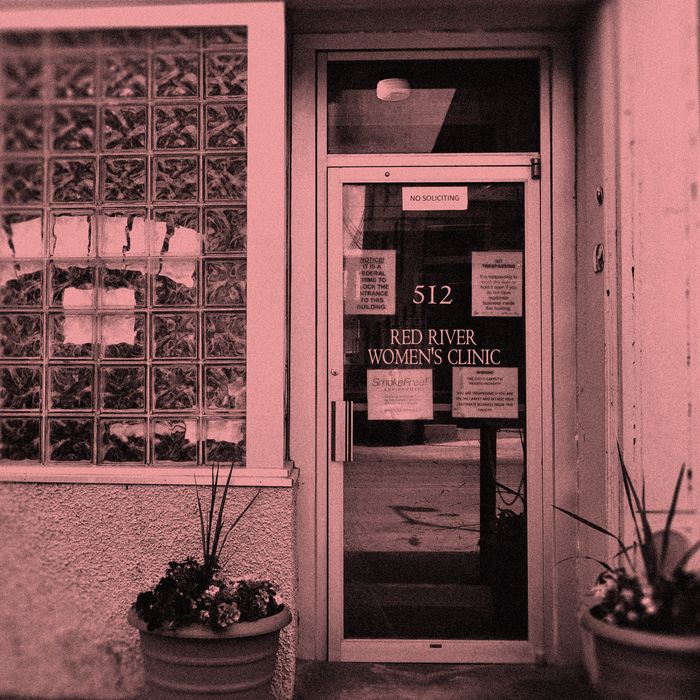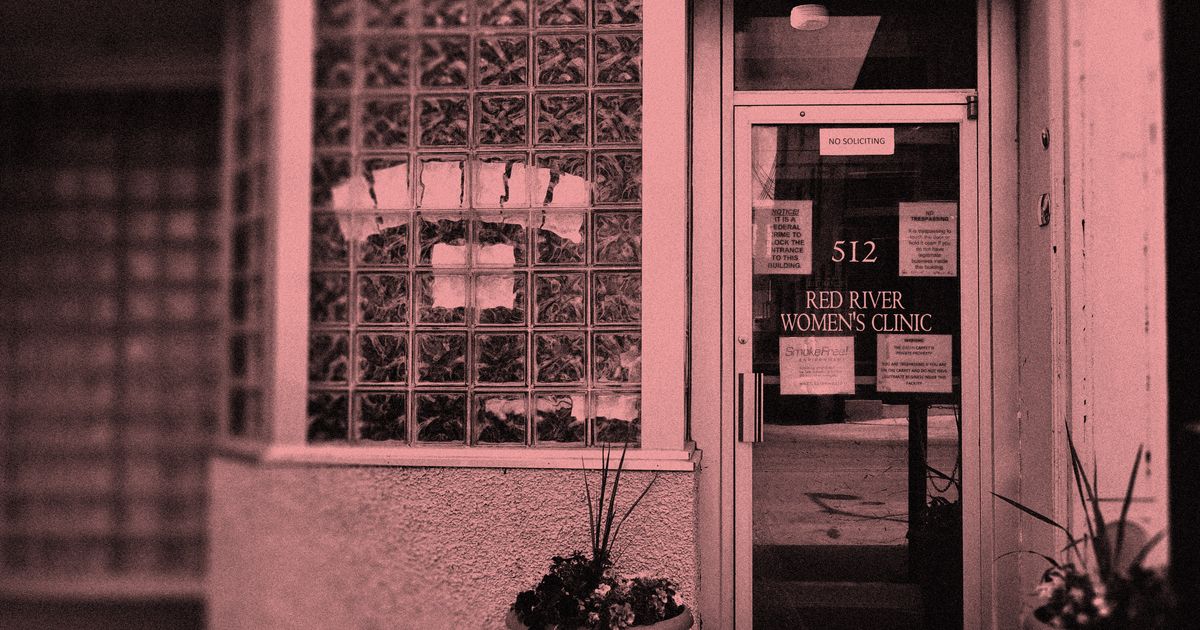
Photo-Illustration: The Cut; Photo: Reuters
While the world was reeling from the reality that the U.S. Supreme Court had actually overturned Roe v. Wade last month, Tammi Kromenaker didn’t have time to process her emotions. She was focused on something else: How much time do I have?
The answer, it turned out, was five weeks. Four days after the Dobbs ruling came down, North Dakota’s attorney general certified the state’s trigger law, officially banning abortion in North Dakota beginning July 28. For nearly 25 years, Kromenaker has worked with Red River Women’s Clinic in Fargo, North Dakota, the only abortion clinic in the state, most recently as its director and owner. On July 7, Red River Women’s Clinic filed a lawsuit to keep the trigger ban from going into effect on that date, but even if successful, that will only buy the clinic a bit more time.
Kromenaker and I first spoke four days before the Supreme Court ruling, and three days before she would close on a building in Moorhead, Minnesota, roughly one mile away from Fargo. Without any trigger laws on the books, and a Democratic governor who recently issued an executive order in support of abortion rights, Minnesota is likely to keep abortion legal. That building will soon be the new home of Red River Women’s Clinic.
Kromenaker’s blonde bob and wide smile belie her age (50) and her years of experience (nearly 30). She is warm and welcoming; “I’m a midwestern gal,” she tells me, though she admits she’s also a bit of a “control freak” — she has to be. No one else is as invested in or knowledgeable about Red River Women’s Clinic as she is, and the number of tasks she’s balancing at any given moment is staggering. “It’s not just a job,” Kromenaker tells me. “It’s a calling.”
During that early conversation, Kromenaker was anxious to have the closing papers signed so she could start on the dozens of other items on her to-do list. I scrambled to get them all down as she flew through them: getting the clinic licensed in Minnesota; finding a new lab director who is eligible to work in Minnesota; changing the clinic’s address on every letter, envelope, and web listing; the list went on.
How much was this all going to cost? She started tabulating.
The HVAC? Probably about $150,000. Security cameras? $16,000. Plumbing upgrades? $5,000. Shoring up the roof? $3,000. A land survey to assess traffic flow? Repairing the broken fence to protect patients and staff? Installing bulletproof glass in every window and installing phone lines and IT infrastructure? Tens of thousands of dollars more. “So yeah,” she chuckled. “We need money.”
That said, “we’re scrappy,” Kromenaker tells me. “I could do so much with $100,000.” But that would only address a fraction of the immediate concerns of setting up the clinic, rather than longer-term solvency and the ability to make the facility exactly what she believes patients deserve.
How much would that cost? “$1 million — that would be my pie in the sky.”
To her astonishment, money has come. Two days after we spoke, on June 23, a supporter of Red River Women’s Clinic created a GoFundMe to solicit donations for the clinic’s move across the river. The goal was $20,000. Less than 24 hours later, the Supreme Court overturned Roe v. Wade, and the donations skyrocketed to more than $250,000. Today, the clinic has raised more than $960,000. It is just shy of that $1 million.
The number feels both astonishing and not enough. When abortion is officially banned in North Dakota later this week, it will join South Dakota’s ban that’s already in effect, creating an abortion-services desert that stretches up to 500 miles. Kromenaker and her staff had already seen an increase of out-of-state patients after Roe fell — where will they, and now also the residents of North Dakota, go after this Wednesday? This question has placed inordinate pressure on Kromenaker and her staff to make this move happen. But what other choice do they have?
If it weren’t for the constant hub of protesters gathered out front, it would be easy to miss Red River Women’s Clinic. On the outside, it looks like a typical office building on a city’s main drag. The first-floor windows are a wall of glass bricks for privacy, and the main identifying sign is located on the side of the building, overlooking the clinic’s private parking lot.
Inside, there’s a warm, plant-filled waiting area where patients sit before meeting with a staff member who talks through their options, explains what to expect, and answers any questions. If this is their first appointment, they will have to wait another 24 hours before coming back to have an abortion, per North Dakota law. Once they do, they then enter a private room with comforting lavender walls where they have an ultrasound to ensure the pregnancy is within North Dakota’s gestational limit of 20 weeks. Following the procedure, the patient waits for some time in the recovery room, with reclining chairs, light-pink walls, and a television, where they are monitored by a nurse post-abortion until they are ready to be discharged.
In other words, it’s your average “nice” doctor’s office, except for the cries of “murderer” coming from out front.
Since becoming the only abortion clinic in North Dakota in 2001, when nearby Fargo Women’s Health Clinic closed its doors for financial reasons, Red River Women’s Clinic has provided care for an estimated thousands of patients.
One of them was Sarah Haeder, who found out she was pregnant in 2006. “I was in a new relationship, and I did not want to continue the pregnancy, so I came to Red River Women’s Clinic,” she says. “I was so impressed with how well they treated me that when I left, I told my partner at the time, ‘I’m going to work there.’” Two years later, she joined the staff as a patient educator. She was so moved by the work that she went back to nursing school in 2012 and is now the clinic’s head nurse.
Haeder, who is a licensed nurse in both North Dakota and Minnesota, is joining Kromenaker across the river. “Probably the easiest part of the transition,” she says, is not having to worry about getting licensed in another state. Same goes for the clinic’s “other nurses or doctors because we all both work in North Dakota and Minnesota, just because of how close we are just across the river.” It’s not uncommon to have nursing licenses in more than one state. Nurses can acquire a multistate license, particularly if they think they may end up leaving the state in which they currently work. Because of the proximity of Red River Women’s Clinic to the North Dakota–Minnesota border, and because some of the staff live in Minnesota themselves, it made sense to Haeder to have a license in both states. Now, it’s a lifeline.
But, of course, they can’t take everyone with them. “I’m mourning some of the relationships that I know I’m going to lose in North Dakota,” Kromenaker tells me. She began working at Fargo Women’s Health in 1993, becoming the clinic’s administrative assistant before leaving for Red River Women’s Clinic, which opened its doors in 1998. “After 29 years of doing this work,” Kromenaker continues, “I have to basically start from square one and navigate a new landscape.”
For example, Red River Women’s Clinic provides free assistance to young people accessing abortion care through judicial bypass in North Dakota. What’s that process like in Minnesota? Whose number at the Minnesota Department of Health does Kromenaker need to know, and how can she develop that relationship in a matter of days, rather than years?
Of some comfort is the growing group of volunteers. In the immediate aftermath of the Dobbs ruling, the clinic has seen a wave of new volunteers, says Gary Lura, a six-year veteran clinic escort at Red River Women’s Clinic. Their sizable presence, up to 30 on any given day, has mitigated the worst of the protesters.
Typically, Lura stays by the door, his bodybuilder frame lending a sense of external security to the clinic. The rest of the volunteers fan out across the sidewalk, intercepting patients from protesters, shielding them from the phone cameras pointed at them by filming protesters, trying to keep them calm. The clinic escort team has a well-established system to support patients, and every volunteer knows precisely how they fit into it. But once the clinic moves to Moorhead, the team will have to adapt to an entirely new setup outside the clinic. The tactics they’ve honed over years in Fargo might not be easily replicable at a new facility with different points of entry. Lura expects that most, if not all, of the current volunteers will make the move to the new location, and the surge of folks who have reached out since Roe was overturned could increase their team’s size.
Lura will continue as a clinic escort across the river in Moorhead. He acknowledges that as a North Dakota resident, this could potentially put him at legal risk if North Dakota moves to criminalize assisting abortion patients in other states. “It has crossed my mind, but I plan to keep going.”
Kromenaker knows her staff still has fears about all this. “I have people who rely on this paycheck to pay their mortgage, to pay their bills,” she says. What if this move doesn’t actually happen? What if Red River Women’s Clinic is forced to close permanently? Could they all lose their jobs? Could those who live in North Dakota face potential criminalization? There are endless questions and fears amid the chaotic realignment and emboldened opposition in a post-Roe world.
“I know they trust me, but that’s an enormous amount of pressure,” Kromenaker adds with a sigh. Then, suddenly, she’s upbeat again. “Okay, we’re going to make this happen!”
That quick switch between anxiety and positivity is a signature of Kromenaker’s — a survival tool. The relentless bright-side thinking that refuses to give into despair. Kromenaker had seen the writing on the wall for years. But it wasn’t until the Supreme Court upheld SB8, the Texas law that banned abortions at six weeks and deputized private citizens to enforce it, that she knew she had to act. “That was the first time we met with the Realtor,” she says. That foresight has helped create what they hope will be as seamless a transition as possible from their old location to their new one.
“I’m also trying to live my life,” she tells me. “I want to enjoy the beautiful garden that we put in, but I feel like every minute of every day has to be devoted to this clinic.” Kromenaker acknowledges that she has a support system — her husband, her family, and the large network of friends and supporters she’s cultivated. Still, the burden of moving this clinic and avoiding a single day of lost abortion care is still largely hers to shoulder.
“We are ready to see patients in MN next week if we cannot provide in ND,” she tells me when I check in via text a few days ahead of July 28. I ask how she’s feeling. “It’s really hard right now as we are in limbo,” she tells me. “I’m exhausted and stressed, but we got this!”
See All






More Stories
Exploring the Magic of Sapphire Engagement Rings in Birmingham’s Jewelry Quarter
Unlocking the Expertise of Women’s Care Specialists: A Comprehensive Guide
Women’s Birth and Wellness Center: A Comprehensive Guide